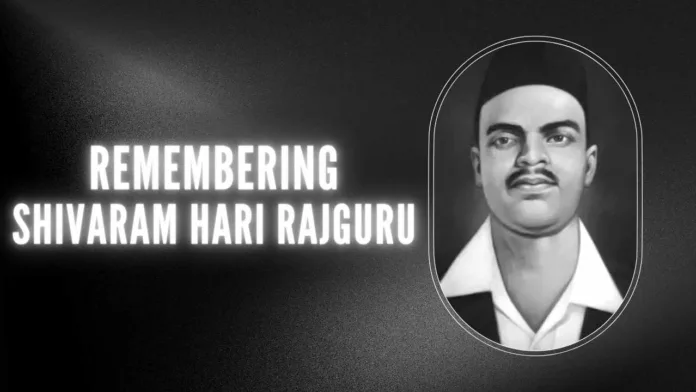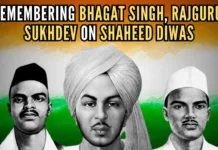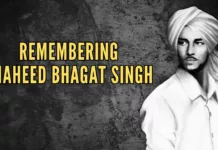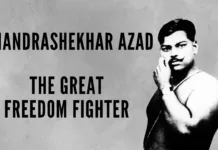
Remembering Shivaram Hari Rajguru on his birth anniversary
Shivram Hari Rajguru was born on the 24th of August of 1908 in Khed in what is present-day Pune district on the banks of the river, Bheema in the land of the great Marathas, Maharashtra in Bharat. His parents were Parvati Devi and Harinarayan Rajguru. He was born in a Marathi Deshastha Brahmin Hindu family. His parents were pious and simple souls. Patriotism ran in in his blood.
Shri. Rajguru obtained his primary education at Khed. He studied at New English High School in Pune. He was patriotic since childhood. He did not approve of Bharat being ruled by an alien imperialistic regime.
He was a member of Seva Dal. He attended a Training Camp by Dr. M.S. Hardikar at Ghatprabha. He became a revolutionary after joining HSRA. HSRA was the Hindustan Socialist Republican Association. It was a revolutionary group of freedom fighters founded by Sachindra Sanyal, Ram Prasad Bismil, and others. He became close to the other revolutionaries in HSRA like Bhagat Singh and Sukhdeo Thapar. Shivaram Rajguru was greatly inspired by the inimitable Chandrashekhar Azad, who was a great freedom fighter.
Bhagat Singh, the daring revolutionary from Punjab was inspired by Kartar Singh Sarabha, the founder of the Ghadar Party. Shivaram Rajguru, Bhagat Singh, and Sukhdeo Thapar were the beloved associates of Chandrashekhar Azad. Chandrashekhar Azad often led the Trio into strong actions against the British.
Bhagat Singh and Shivaram Rajguru were both members of the HSRA – Hindustan Socialist Republican Association. In December 1928, they plotted the assassination of the Superintendent of Police, James Scott in Lahore to avenge the death of Lala Lajpat Rai.
Lala Lajpat Rai had died after being hit by police while on a march in Lahore protesting against the Simon Commission. However, they ended up killing Assistant Superintendent of Police, John Saunders on the 17 of December 1928.
They were convicted on the charges of the murders of John Saunders and were sentenced to death.
There was an escape plan after the assassination of John Saunders. Bhagat Singh disguised himself as a senior government officer. Bhabhi Durga ji, wife of freedom fighter, Bhagawati Charan disguised herself as the officer’s wife. Shivaram Rajguru disguised as their servant. They escaped for some time but were later caught by the cruel and illegitimate imperialists.
The year was 1929. Lord Irwin was the Viceroy of India. Lord Irwin introduced two bills in 1929. The first was the Public Safety Bill and the second was the Trade Disputes Bill. The Bharatiya people were not happy with the high-handedness of the British rulers.
Chandrashekhar Azad came up with the plan to bomb the Central Assembly in Delhi and also to throw hand-outs. Bhagat Singh, the fiery revolutionary from Punjab was the person to bomb the Central Assembly. Bhagat Singh along with Batukeshwar Dutt threw a bomb at the Central Assembly on the 8th of April 1929. The Revolutionaries wanted to make the deaf British rulers hear the painful wailings of the suffering Bharatiya people under the cruel, exploitative, unjust, foreign, and imperialist British rulers. Thus, Bhagat Singh and Batukeshwar Dutt threw bombs in the Imperial Assembly and raised slogans of ‘Inquilab Zindabad’ and courted arrest.
23rd March of 1931 was indeed an extremely sad day for Bharat Mata, who lost three of her most precious children. Bhagat Singh, Sukhdeo Thapar, and S Rajguru were hanged on that day at Lahore Central Jail. In fact, they were hanged one day, earlier than planned – another conspiracy by the British authorities because the latter were very afraid of ‘The Trio’, who were very popular Freedom Fighters, who by their willingness to die for the motherland had earned the immense respect and love from the Bharatiya masses.
They were cremated at Hussainiwala on the banks of the Sutlej River in Ferozepur in Punjab. There are tens of thousands of people, who throng the Memorial in Hussainiwala to pay homage to these great truly martyred freedom fighters.
Hence, the Trio of S Rajguru, Bhagat Singh, and Sukhdeo made the supreme sacrifice on the 23rd of March of 1931. They were to be hanged on the 24th of March of 1931 but were instead hanged a day earlier as the ALIEN GOVERNMENT was afraid of the repercussions of the hanging and did not want the Bharatiya people to side with the Freedom Fighters. The other Martyrs’ Day in Bharat is marked on the 30th of January when Gandhi ji was assassinated. Nothing could be more ironic in this world than the way, Martyrdom is understood or interpreted.
The sacrifice of Chandrashekhar Azad, Bhagat Singh, Rajguru, and Sukhdev Thapar is more important now in the context of the Amrit Mahotsav or completion of 75 years of Independence, wherein we Bharatiya people need to recall the sacrifice of our freedom fighters. Did the freedom fighters die in vain to witness this extreme rise in human population, falling standards of culture and morality, extreme levels of pollution and corruption, degeneration of the environment, rising crime rates, rise in the use of intoxicants and bad habits, lack of humanity, courtesy and kindness etcetera?
Khed has been renamed as Rajgurunagar. In April 2023, the Maharashtra government told a large panel of 30 members headed by the Pune Divisional Commissioner to submit a fresh plan for the redevelopment of Shivaram Hari’s ancestral home at Rajgurunagar, 45 kms from Pune City.
The state government of Maharashtra has already committed Rs.150 crores for the redevelopment plan and has sanctioned Rs.30 lakhs for carrying out repairs of the House of Rajguru, which will be converted into a Memorial. Shri. Rajguru’s Memorial is to be developed in the heart of Rajgurunagar. The Entrance Gate to the Memorial is complete and work is on to complete the rest of the Memorial on time.
The Honourable Prime Minister of India, Shri. Narendra Damodardas Modi ji has appreciated the contributions of our great freedom fighters and has poured encomiums on Chandrashekhar Azad, Shivaram Rajguru, Bhagat Singh and Sukhdev Thapar on various occasions. There is a memorial dedicated to S Rajguru spread over 2,788 square metres of land. There is also a college named after S Rajguru. It is known as Shaheed Rajguru College of Applied Sciences for Women. It is situated in Delhi and is affiliated to Delhi University.
The legacy of Shivaram Rajguru is illustrious and lasting.
Note:
1. Text in Blue points to additional data on the topic.
2. The views expressed here are those of the author and do not necessarily represent or reflect the views of PGurus.
PGurus is now on Telegram. Click here to join our channel and stay updated with all the latest news and views
For all the latest updates, download PGurus App.
- Shaheed Diwas: Remembering Bhagat Singh, Rajguru, Sukhdev on Martyr’s Day - March 23, 2024
- Chhatrapati Shivaji Maharaj – The unparalleled visionary leader - February 19, 2024
- The Constitution Day of Bharat - November 26, 2023










